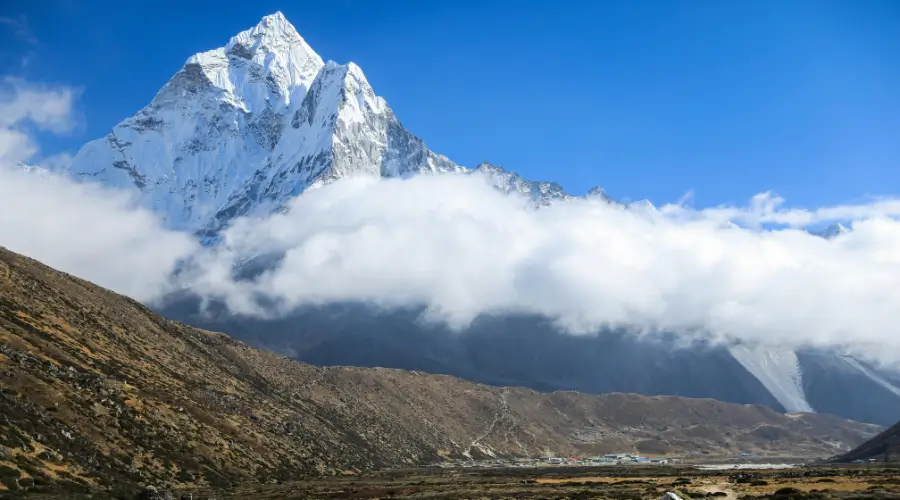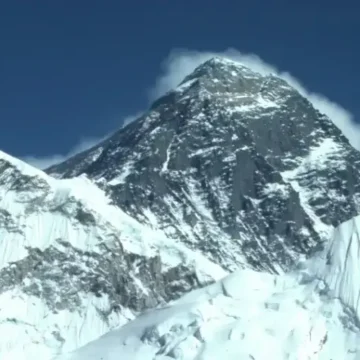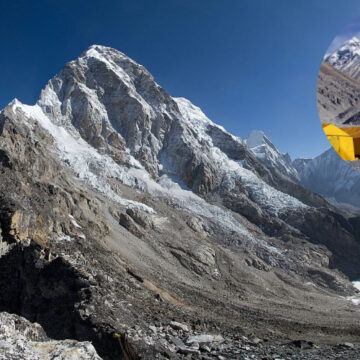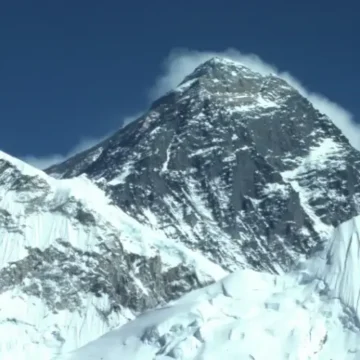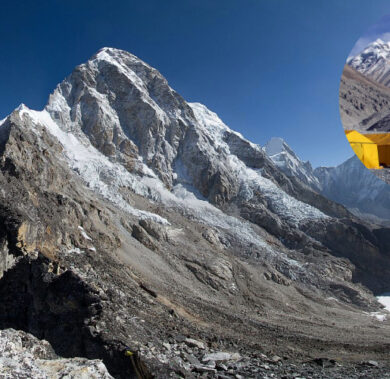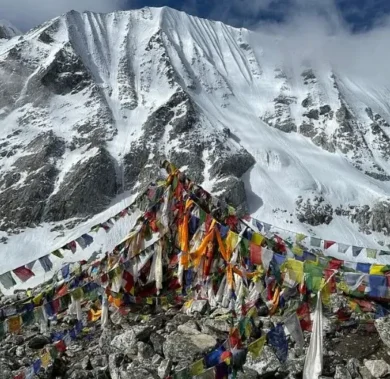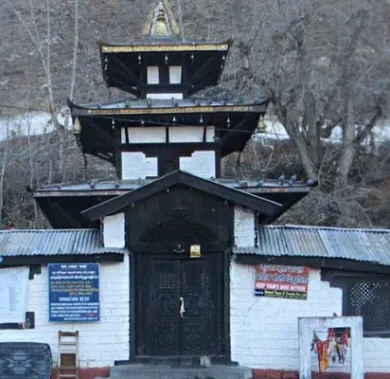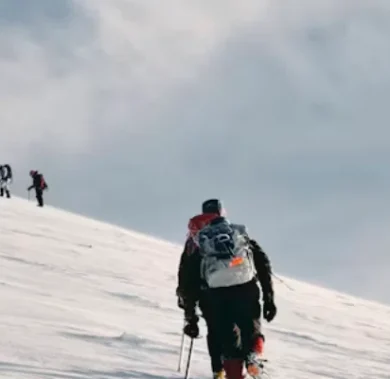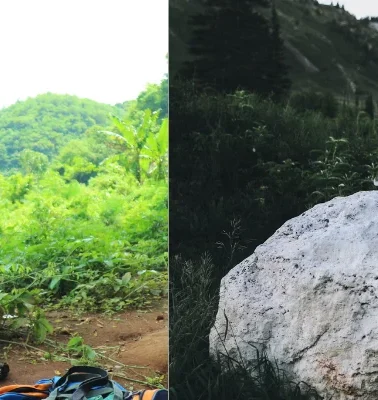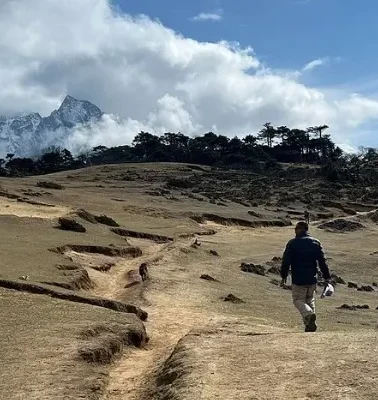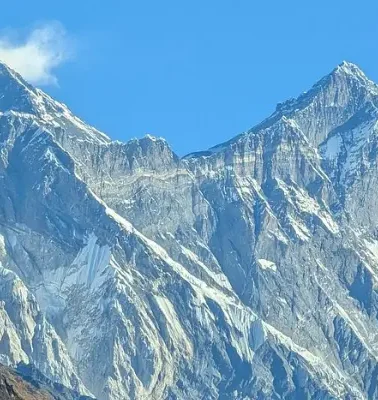
EBC Altitude Sickness: A Complete Guide to Avoid
Table of Contents
Everest Base Camp (EBC), lying within the Khumbu region of Nepal, is a wonder. EBC trek is known for its magnificent view of the world’s excellent mountain, Mount Everest (8848.86 meters). In this guide, we will learn about EBC Altitude Sickness.
The Everest Base Camp trek roughly concludes 130 km; within this distance, you will be mesmerized by the varied terrains, unpredictable Everest Base Camp weather, diverse flora and fauna, etc.
Along with the thrill, satisfaction, and enthusiasm offered by the Base Camp Trek, there are various dangers, such as Everest Base Camp altitude sickness (EBC altitude sickness), hypothermia, hypoxia, etc.
Annually, Mount Everest Base Camp welcomes more than 50,000 visitors, all combined Sagarmatha National Park visits, Everest Base Camp trek, and Mount Everest climb. The Everest Base Camp elevation reaches the highest altitude of 5,364 meters (17,598 feet). The Mount Everest Base Camp trek is comparatively more difficult than other low-altitude treks.
The Everest Base Camp altitude reaches a significant height where there are chances of being a victim of altitude sickness and other risks. Therefore, it is advised that you add 1 or 2 days for acclimatization to your Everest Base Camp hike itinerary.
What is EBC Altitude Sickness?
The EBC altitude sickness or Acute Mountain Sickness (AMS) is a condition people encounter as they ascend to higher altitudes (normally altitude over 2500 meters) without acclimatizing.
As we move to higher altitudes, the density of breathable oxygen at Everest Base Camp decreases significantly. So, our lungs do not get enough oxygen, resulting in altitude sickness at Everest Base Camp. Altitude sickness affects our respiratory system.

The early signs of the EBC altitude sickness are headaches, nausea, fatigue, dizziness, loss of appetite, and insomnia. It is crucial to recognize these early symptoms of altitude sickness Everest. If not recognized on time, it might result in fatality.
It is recommended that your high-altitude trek itinerary should include an acclimatization day and ascend only about 500 meters of height. We need to look for the Everest Base Camp Helicopter evacuation in an emergency.
Anyone who wants to explore the Khumbu region and Base Camp requires decent physical and mental stability. You need to have good cardiovascular and be mentally prepared for any kind of risks that might happen.
For a better, safe, and comfortable travel experience, book your trek with Himalayan Masters at the most affordable Everest Base Camp cost.
What is AMS Altitude Sickness?
AMS altitude sickness is a condition of a body where one of our sensory organs feels that our body is not in balance while other sensory organs are stable.
The inner ear and eye feel that our body is unstable. This leads to dizziness, nausea, headaches, etc. Fatigue, shortness of breath, loss of interest in eating, and insomnia are other symptoms of AMS altitude sickness.
These symptoms could last for a few hours. The best way to encounter altitude sickness at Everest Base Camp is to acclimate to the rapid increase in elevation, eat a balanced diet, and stay hydrated.
Acclimatization is getting accustomed to the rapid increase in altitude and decreasing Everest Base Camp’s oxygen level. You can adjust to the EBC altitude by slow and gradual ascension, including rest/acclimatization day in your trekking itinerary, but climbing to a higher altitude, descending to a lower altitude area and spending the night.

Causes of Everest Base Camp Altitude Sickness
With the increase in altitude, generally above 2,500 meters, the availability of breathable oxygen at Everest Base Camp becomes scarce. To fulfil the required amount of oxygen by our lungs, the body starts to breathe rapidly and increase heart rate.
This causes leaks in fluids on our capillaries and causes altitude sickness at Everest Base Camp. The following elements can cause altitude sickness effects during the trek:
- A sudden increase in elevation
- Exhaustion
- Dehydration
- Hypothermia
- Consumption of neuroleptics
- Physical and mental health.
Who is Prone to Altitude Sickness?
People with certain conditions or lifestyles are more likely to get altitude sickness. Those who live at low altitudes and suddenly travel to high-altitude regions are more prone to symptoms.
Similarly, individuals who ascend too quickly without giving their bodies time to adjust are at higher risk. Poor physical fitness is not always a factor; even healthy people can experience it.
Age, gender, or physical health does not guarantee immunity to altitude sickness. However, those with previous altitude sickness experiences or breathing issues, like asthma, should be extra cautious. Smokers or people with dehydration and poor hydration habits are also at a greater risk.
How to Avoid Altitude Sickness at Everest Base Camp?
You can follow several approaches to avoid altitude sickness at Everest Base Camp. You can follow these methods to tackle low oxygen levels at Everest Base Camp.
Ascent gradually overcame the depleting Everest Base Camp oxygen level. The body needs to get habituated to the decreasing oxygen level as we move to higher altitude treks, such as Everest Base Camp, Annapurna Base Camp, and Manaslu Base Camp.
In general, it is recommended that we ascend only 500 meters a day with proper rest; it is a tolerable height for acclimatizing. Also, we can and need to include a rest day or acclimatization day in our itinerary. This method gives us enough time to acclimatize to the increasing height and thin oxygen level.
i. Get Proper Hydration and Nutrition
The Everest Base Camp oxygen level gets thinner and thinner as we move towards Base Camp. The presence of thin air extracts moisture from our body, dehydrating the body. This is the main cause of catching altitude sickness at Everest Base Camp. To tackle this, we must drink a sufficient amount of water.
Not only the thin air but also sweat can cause dehydration. So, it is advised to drink 500 ml of lukewarm water every half hour’s interval. Avoid any consumption of chilled water.
Likewise, a balanced diet is equally important as any other method to avoid Everest Base Camp altitude sickness. It is usual to lose appetite due to exhaustion at high altitudes. The body burns more energy during the Everest Base Camp trek.
To overcome calorie deficit, remember to eat healthy foods in Everest Base Camp that are easy to digest and contain high calories available in the area. Avoid trekking on an empty belly or when you are on a diet.
ii. Be Physically and Mentally Fit
Physical and mental strength might not be critical points in avoiding altitude sickness. However, being physically strong and mentally stable will surely be a key asset. The Everest Base Camp Trek is a challenging trek requiring physical and mental fitness. Even the fittest can be victims of altitude sickness.
It will prove beneficial if you have good stamina and are in good shape to tackle an unforeseen obstacle. A psychological state can be a prime asset for building confidence and enjoying the trip. Being one with nature can be an escape from altitude sickness and a hectic schedule.
To improve your strength and stamina, you can do a few strength-building exercises like running, skipping, swimming, cycling, etc. Additionally, you can do yoga, meditation, asana, etc., to improve your mental strength. Consult with your doctor if you are physically and mentally fit if required.
iii. Avoid Drinking Alcohol and Smoking
The thin air dries up your body’s liquid with increased altitude. Over that, consumption of alcohol and smoking further dries your internal liquid level and reduces Everest Base Camp’s oxygen level from our tissues. A decent amount of alcohol and smoking is acceptable after moving to a lower altitude, but not more.
iv. Medication
In case of any emergency or altitude sickness, acetazolamide (Diamox) is the most common medicine prescribed to avoid and reduce the symptoms of Everest Base Camp altitude sickness. A steroid, Dexamethasone, can overcome depleting oxygen levels at Everest Base Camp. This medicine might not be available everywhere, so get information beforehand.
However, without experts’ advice, they should not take any medication. You can choose other home remedies, such as garlic and ginger soup.
v. Other ways that we can avoid altitude sickness at EBC
Apart from the abovementioned methods, you must be aware of various other aspects to prevent altitude sickness at Everest Base Camp. One thing you need to be aware of is the recognition of early signs of altitude sickness. Therefore, recognising early symptoms of altitude sickness can be a lifesaver. We must be aware of our physical limits and seek help if needed.
Additionally, being mentally prepared and able to take instant action is crucial in cases on high-altitude treks such as the Manaslu Circuit Trek, Langtang Valley Trek, Annapurna Circuit Trek, etc. In case of severe conditions, you need to be able to take the best possible action, whether it be descending to a lower altitude or helicopter evacuation.
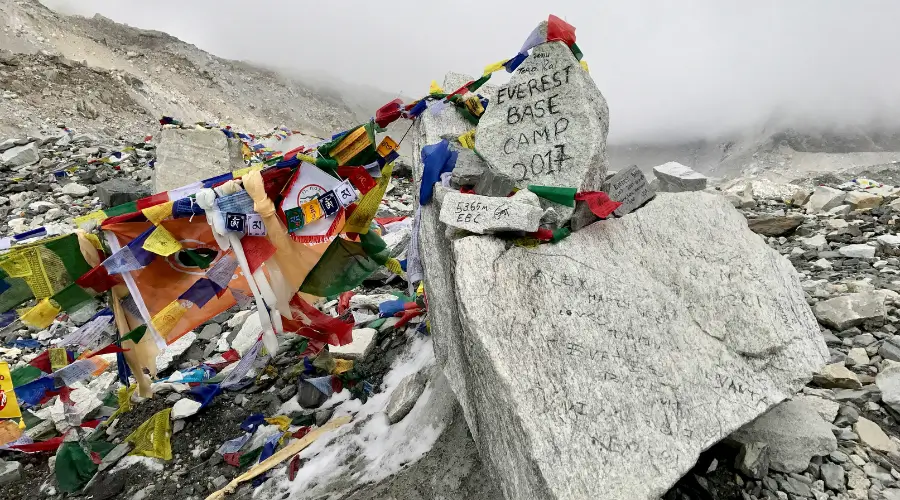
Supplements to Prevent Altitude Sickness
We have made a list of the best supplements that are used to prevent altitude sickness:
- Bring iron tablets.
- Magnesium.
- Vitamin C, D, E and B6 too.
- Magnesium tablets.
- Gingko Biloba.
Natural Herbs to Prevent Altitude Sickness
- Garlic
- Indian wormwood
- Sichuan Pepper
- Ginger
- Cloves
- Peppermint
Significance of Acclimatization During EBC Trek
Acclimatization helps a lot during altitude sickness. As you will not hike or trek during the day and rest, it will help maintain oxygen and blood flow during the trek.
But why should one acclimatize during the trek at Everest Base Camp? It is necessary due to the sudden changes in altitude. As you will directly hike from 2170 to 3400 meters, your body must rest at such an altitude.
Also, in Dingboche, you will hike from 3860 meters to Tengboche and then to Lobuche at 4910 meters. It would help if you rested a day before in Dingboche to acclimate.
What Elevation Causes Altitude Sickness?
The chances of altitude sickness start at an elevation of 2,500 meters, but generally, people feel altitude sickness at around 3,500 meters. In the case of the EBC trek, Namche Bazaar lies at an elevation of 3,440 meters, so trekkers start suffering from altitude sickness from here. Our itinerary includes an acclimatization day at Namche Bazar to avoid altitude sickness.
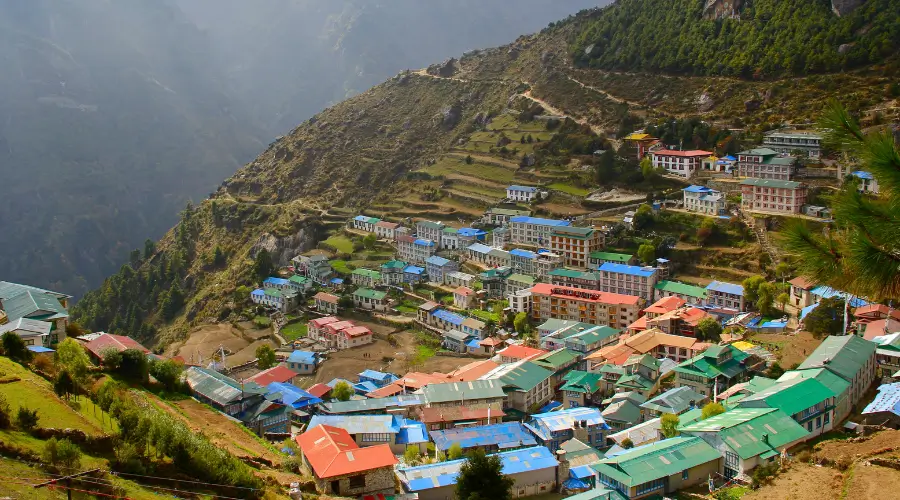
What happens if you get altitude sickness during the EBC Trek?
If you get altitude sickness during the EBC Trek, please inform your guide immediately. Drink enough water and take Diamox as a medicine to reduce altitude sickness during the trek.
Then, after resting for a while, identify the type of altitude sickness you have: AMS, HAPE, or HACE. If the condition is AMS, you do not have to worry much since supplements can reduce altitude sickness.
But if the condition is HAPE or HACE, you must climb to a lower altitude or ask for a helicopter evacuation. To have a helicopter evacuation, you must have travel insurance that covers all of the evacuation charges.
FAQ
Can you get altitude sickness at Everest Base Camp?
Everest Base Camp is a high-altitude trek. So, you are likely to get altitude sickness.
What is the altitude of Everest Base Camp?
The altitude of Everest Base Camp is 5,346 meters (17,598 feet).
What are the effects of high altitude to low altitude?
Moving from high altitude to low altitude has positive effects. Headaches, nausea, dizziness, shortness of breath, etc., are all solved.
Can altitude sickness be dangerous?
Yes, altitude sickness can be dangerous; in the worst case, it could be fatal. Identifying the early signs of Everest Base Camp altitude sickness is better for fully disclosing the challenges during the EBC trek.
Can altitude sickness cause body aches?
Along with other symptoms of altitude sickness, body aches are common symptoms of altitude sickness.
Can altitude sickness cause chills?
In response to depleting oxygen levels at Everest Base Camp, altitude sickness can cause chills to counter to maintain body temperature.
Can altitude sickness cause diarrhea?
Yes, altitude sickness can cause diarrhea. Due to lack of oxygen at the high altitude, your body will cause Gastrointestinal tract pain.
Does canned oxygen help with altitude sickness?
Yes, having canned oxygen will help you reduce altitude sickness as it will help you increase the oxygen level in your body.
Want to know more?
Speak to an Expert





Sandip Dhungana
Nepal 🇳🇵
Whatsapp: +977-9823636377

